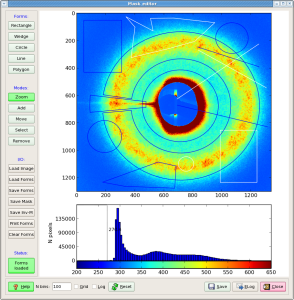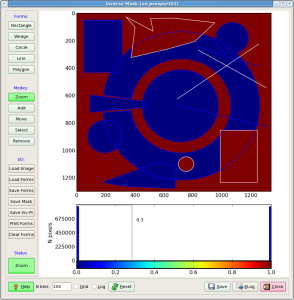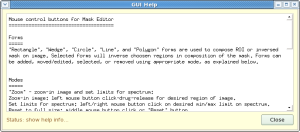Mask Editor is intended for interactive selection of good and bad regions on 2D image and preparation of output files with direct and inversed masks. It works as a basic graphical editor with specific output.
User Interface
Mask Editor's user interface is working in a single window containing three pannels; graphical window, left-hand and bottom side control bars. Content and functionality of these panels is described below. Most of control buttons have tool tip hints; when coursor stops for a few seconds on control button, a pop-up window uppears with explanation of functionality of this button.
Graphical window
Left control bar
Left control bar consists of stack of buttons, which are functionally splitted for four groups; Forms, Modes, I/O, and Satus, which content and functionality is explained in this section.
Forms
Forms can be used as non-selected - "positive" for ROI, and selected - "inversed" for blemish mask.
Modes
Section of modes contain Zoom, Add, Move, Select, and Remove buttons with functionality literally explained by their names.
I/O
Masks
Masks can be saved as
- ROI - positive
- Blemish - inversed
Satus pannel
Satus pannel is a single button-like pannel, displaying short status messages.
Bottom control bar
How to run Mask Editor
Mask Editor is developed as a part of the integrated data processing environment for XCS time correlation experiments. In this project the Mask Editor is integrated as one of the system GUIs. Also it can be executed as a stand-alone application named med. Stand-alone version of the Mask Editor can launched on any of psana or psexport node using command-line interface, for example, for all default parameters:
sit_setup med
List of optional parameters
> med -h
Usage: med [options]
Optional input parameters.
Options:
-h, --help show this help message and exit
-i IFNAME, --fname_img=IFNAME
input image file name
-o OFNAME, --fname_fig=OFNAME
output png file name for current canvas
-m MFNAME, --path_mask=MFNAME
common path to I/O files with mask
-t TITLE, --title=TITLE
initial title of the garphical window
-x XC, --xc=XC x coordinate of the center for Wedges
-y YC, --yc=YC y coordinate of the center for Wedges
-p PICKER, --picker=PICKER
distance in pix, where object line can be reaced by
mouse
-w LW, --lw=LW object line width
-c COL, --color=COL color of the form lines "b"-blue, "k"-black, etc.
-v, --verbose allows print on console
-q, --quiet supress print on console
I/O of forms
Forms can be saved in file, loaded from file and displayed on image, printed on console monitor, and cleared/removed from image. This can be done using simple data representation for each form, which is quite self-explained in case of pront or text-file format:
Form parameters for composition of the mask Rectangle 48.00 50.00 262.00 380.00 1 b False False Rectangle 987.00 853.00 255.00 380.00 1 w True False Wedge 716.76 674.72 541.18 197.61 -171.39 174.59 1 b False False Wedge 674.48 667.64 585.84 386.69 174.75 186.99 1 b False False Circle 712.00 674.00 262.00 1 b False False Circle 1068.00 180.00 112.00 1 b False False Circle 191.00 898.00 117.00 1 b False False Circle 752.00 1098.00 53.00 1 w True False Line 689.79 1252.80 624.50 223.22 1 w True False Line 829.99 1252.80 244.47 388.46 1 b False False Line 836.67 1303.98 268.07 541.89 1 w True False Line 692.02 1315.11 669.35 827.50 1 b False False Polygon 1 w True False 10 400 373 620 ... Polygon 1 b False False 6 329 674 683 ...
Demonstration of features





